“YJ? TJ? XJ? What do those mean?”
That’s a question that gets asked a lot by newcomers to the Jeep world. In an effort to simplify the answers that people must continually post the the various Jeep lists, I’m creating this page. The ?J terms that people use are actually the first two letters of the body style designation assigned by Jeep to each major body style revision. I know I’m leaving out some models and a lot of production dates, so holler if you’ve got info not listed here.
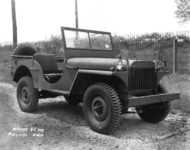 MA – The original prototype Jeep submitted by Willys-Overland for the military contract in 1940. “M” stood for “military”; “A” for the first model.
MA – The original prototype Jeep submitted by Willys-Overland for the military contract in 1940. “M” stood for “military”; “A” for the first model.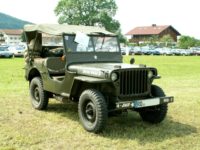 MB – The revised model first mass-produced by Willys-Overland for the military in 1940-1945?. “B” stood for the second model.
MB – The revised model first mass-produced by Willys-Overland for the military in 1940-1945?. “B” stood for the second model.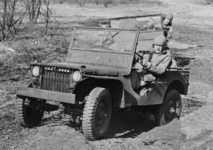 GP – The original prototype Jeep submitted by Ford for the military contract in 1940. “G” indicated government issue; “P” indicated an 80″ wheelbase reconnaissance vehicle.
GP – The original prototype Jeep submitted by Ford for the military contract in 1940. “G” indicated government issue; “P” indicated an 80″ wheelbase reconnaissance vehicle.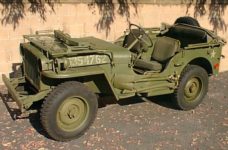 GPW – The revised model first mass-produced by Ford for the military in 1940-1945?. It is virtually identical to the MB (the “W” stood for “Willys’ design”).
GPW – The revised model first mass-produced by Ford for the military in 1940-1945?. It is virtually identical to the MB (the “W” stood for “Willys’ design”).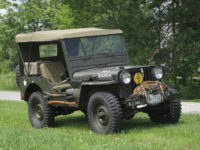 M38 – aka MC – The next generation military Jeep by Willys (1950-1952), similar to the civilian CJ-3A. Like all of the above models, it was a flat-fender style.
M38 – aka MC – The next generation military Jeep by Willys (1950-1952), similar to the civilian CJ-3A. Like all of the above models, it was a flat-fender style.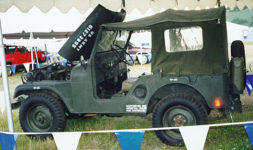 M38A1 – aka MD – Basically the military version of the CJ-5 (1952-1971). Unlike the CJ-5, it had the front shackles behind the springs instead of up front.
M38A1 – aka MD – Basically the military version of the CJ-5 (1952-1971). Unlike the CJ-5, it had the front shackles behind the springs instead of up front.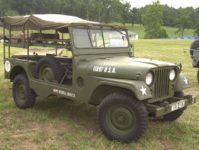 M170 – Similar to a military version of the CJ-6. 4155 of them were made in the mid-50’s and early-60’s.
M170 – Similar to a military version of the CJ-6. 4155 of them were made in the mid-50’s and early-60’s.- CJ – The first civilian version of the military-inspired short-wheelbase Jeep, made 1942-1986. Encompasses everything from flat-fenders to Scramblers. Like many other early Jeep designations, “CJ” actually stands for something: Civilian Jeep. Various numbers followed the CJ designation, indicating different body styles within the CJ line:
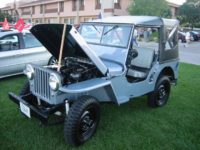 CJ-2A – A flat-fender, very similar to the military MB (1945-1949) except that the headlights bulge out of the grill instead of being inset.
CJ-2A – A flat-fender, very similar to the military MB (1945-1949) except that the headlights bulge out of the grill instead of being inset.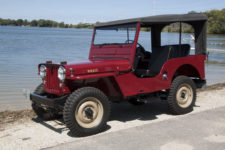 CJ-3A – A flat-fender, very similar to the military M38 (1948-1953).
CJ-3A – A flat-fender, very similar to the military M38 (1948-1953).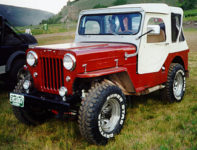 CJ-3B – A flat-fender, the top of its hood sits 4″ higher above the fenders than the 3A to clear the new F-head engine (1952-1968).
CJ-3B – A flat-fender, the top of its hood sits 4″ higher above the fenders than the 3A to clear the new F-head engine (1952-1968).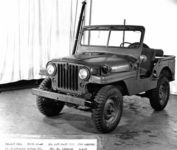 CJ-4 – Only one prototype is known to exist. It was discovered in 1997(?), still in the hands of its second owner. It looks like a 50/50 mix of a CJ-3A and a CJ-5, with only slightly-rounded fenders.
CJ-4 – Only one prototype is known to exist. It was discovered in 1997(?), still in the hands of its second owner. It looks like a 50/50 mix of a CJ-3A and a CJ-5, with only slightly-rounded fenders.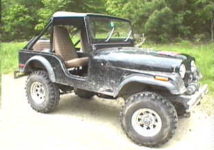 CJ-5 – The civilian version of the M38A1, but with the front shackles under the bumper like most other models. 81″ (1955-1971) or 84″ (1972-1983) wheelbase. Front fenders are rounded like all subsequent short-wheelbase Jeeps. Easily distinguished from the CJ-7 by a small doorway with a rounded, sloping rear edge.
CJ-5 – The civilian version of the M38A1, but with the front shackles under the bumper like most other models. 81″ (1955-1971) or 84″ (1972-1983) wheelbase. Front fenders are rounded like all subsequent short-wheelbase Jeeps. Easily distinguished from the CJ-7 by a small doorway with a rounded, sloping rear edge.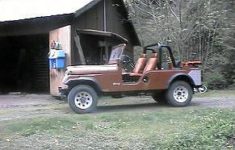 CJ-6 – Essentially a CJ-5 that was stretched 20″ (1958-1975), intended for use as a small pickup.
CJ-6 – Essentially a CJ-5 that was stretched 20″ (1958-1975), intended for use as a small pickup.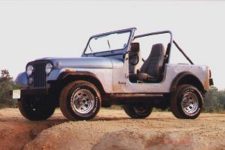 CJ-7 – A compromise between the CJ-5 and CJ-6, having a 93.4″ wheelbase (like the YJ and TJ). The body tub is very similar to the YJ and TJ, but the rear wheel wells are round instead of angular. Made 1976-1986.
CJ-7 – A compromise between the CJ-5 and CJ-6, having a 93.4″ wheelbase (like the YJ and TJ). The body tub is very similar to the YJ and TJ, but the rear wheel wells are round instead of angular. Made 1976-1986.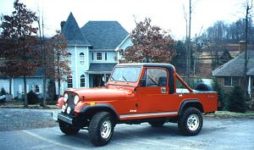 CJ-8 – Also called a “Scrambler.” Similar to a CJ-7, but with an extra 10″ of wheelbase and an even longer rear overhang. Like the CJ-6, it was intended as a small pickup, but never really found its niche. Only 27,000 were made from 1981-1986. Commonly seen with half-cab tops that surround only the front seats.
CJ-8 – Also called a “Scrambler.” Similar to a CJ-7, but with an extra 10″ of wheelbase and an even longer rear overhang. Like the CJ-6, it was intended as a small pickup, but never really found its niche. Only 27,000 were made from 1981-1986. Commonly seen with half-cab tops that surround only the front seats.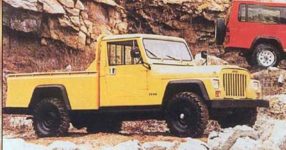 CJ-10 – A more truck-like Jeep built mainly for export from 1981-85. A small number were also sold to the US Air Force for use in pulling aircraft around runways. These Jeeps had very stout drivetrains compared with their smaller brethren. Easily distinguished by the square headlights in the fenders and the 10-slat grille.
CJ-10 – A more truck-like Jeep built mainly for export from 1981-85. A small number were also sold to the US Air Force for use in pulling aircraft around runways. These Jeeps had very stout drivetrains compared with their smaller brethren. Easily distinguished by the square headlights in the fenders and the 10-slat grille.
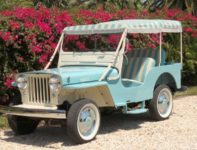 DJ-3A – Dispatcher (postal) version of the CJ-3A, made 1956-1965. Only 2-wheel drive versions were available. Many were used for non-postal duties.
DJ-3A – Dispatcher (postal) version of the CJ-3A, made 1956-1965. Only 2-wheel drive versions were available. Many were used for non-postal duties.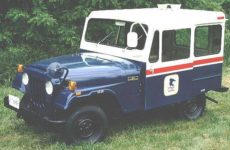 DJ-5 – Dispatcher (postal) version of the CJ-5, made 1965-1984 by Jeep and then AM General. Only 2-wheel drive versions were available. A DJ-6 (long, like the CJ-6) was also made from 1965-1968.
DJ-5 – Dispatcher (postal) version of the CJ-5, made 1965-1984 by Jeep and then AM General. Only 2-wheel drive versions were available. A DJ-6 (long, like the CJ-6) was also made from 1965-1968.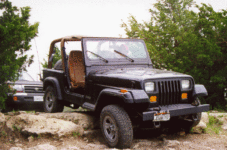 YJ – The original Wrangler, made 1987-1995 (though production actually continued into March of 1996). Rectangular headlights make it the bastard child of the of the short-wheelbase line. Rear wheel wells are larger and more angled than the CJ-7, but otherwise the two are visually quite similar.
YJ – The original Wrangler, made 1987-1995 (though production actually continued into March of 1996). Rectangular headlights make it the bastard child of the of the short-wheelbase line. Rear wheel wells are larger and more angled than the CJ-7, but otherwise the two are visually quite similar.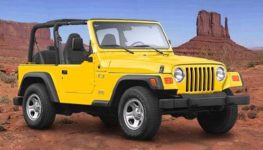 TJ – The second generation Wrangler, made 1997-2006 (actually began shipping May of 1996). Round headlights, coil suspension, and a much more car-like interior distinguish it from the YJ.
TJ – The second generation Wrangler, made 1997-2006 (actually began shipping May of 1996). Round headlights, coil suspension, and a much more car-like interior distinguish it from the YJ.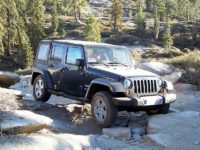 JK/JKL – The third generation Wrangler, built from 2007-2017. It’s somewhat larger than the TJ, and has a rounded windshield and body panels. JK is the 2-door version; JKL is the 4-door.
JK/JKL – The third generation Wrangler, built from 2007-2017. It’s somewhat larger than the TJ, and has a rounded windshield and body panels. JK is the 2-door version; JKL is the 4-door.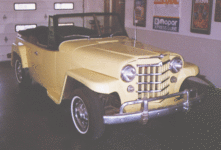 VJ – The Jeepster (1948-1950) was an attempt by Willys to spice up their vehicle lineup. 2WD, 72hp, and poor marketing doomed it to be discontinued after less than three years.
VJ – The Jeepster (1948-1950) was an attempt by Willys to spice up their vehicle lineup. 2WD, 72hp, and poor marketing doomed it to be discontinued after less than three years.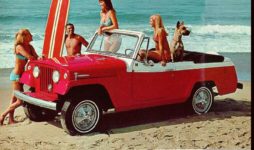 C-101 – The Jeepster Commando (1966-1973) was an attempt by Kaiser to compete with with the Bronco and TLC. The C101 was part CJ and part Wagoneer, advertised as a “happy combo, racy and rugged.” This time around it had 4WD, and came in convertibles, hardtop wagons, and half-cab pickups.
C-101 – The Jeepster Commando (1966-1973) was an attempt by Kaiser to compete with with the Bronco and TLC. The C101 was part CJ and part Wagoneer, advertised as a “happy combo, racy and rugged.” This time around it had 4WD, and came in convertibles, hardtop wagons, and half-cab pickups.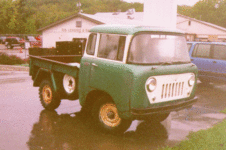 FC – Forward Control pickups, with the cab directly above the engine. Made 1957-1963.
FC – Forward Control pickups, with the cab directly above the engine. Made 1957-1963. MJ – The Comanche pickup (1986-1992). It shares much in common with the XJ of that era, including its front unibody chassis. It replaced the full-size Gladiator and J-truck pickups of the SJ era.
MJ – The Comanche pickup (1986-1992). It shares much in common with the XJ of that era, including its front unibody chassis. It replaced the full-size Gladiator and J-truck pickups of the SJ era.- SJ – The full-size Cherokee (1974-1983), Wagoneer (1963-1983), Grand Wagoneer (1984-1991), and J-truck (1963-1987). In 1984, Jeep introduced the down-sized XJ and started calling them Cherokees and Wagoneers, leaving only the Grand Wagoneer (and, briefly, the J-truck) in the SJ lineup until its demise in 1991.
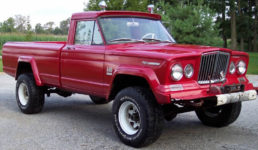
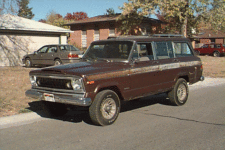
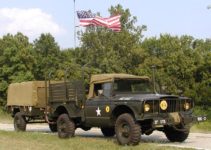 M-715 – A 5/4-ton military pickup built 1967-1969. It somewhat resembles a J-truck (SJ), only bigger and badder. The M-725 was the ambulance version of the M-715.
M-715 – A 5/4-ton military pickup built 1967-1969. It somewhat resembles a J-truck (SJ), only bigger and badder. The M-725 was the ambulance version of the M-715.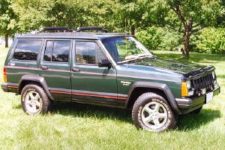 XJ – The down-sized Cherokee (1984-2001) and Wagoneer (1984-1989?). It was (probably?) the first Jeep to use a unibody chassis.
XJ – The down-sized Cherokee (1984-2001) and Wagoneer (1984-1989?). It was (probably?) the first Jeep to use a unibody chassis.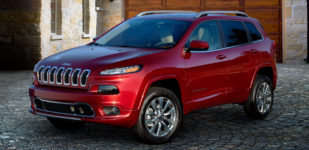 KL – Jeep reintroduced the Cherokee name in 2014. It’s still in production today (2017).
KL – Jeep reintroduced the Cherokee name in 2014. It’s still in production today (2017).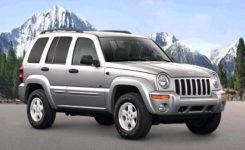 KJ – The Liberty (2002-2007), which replaced the XJ in Jeep’s product lineup.
KJ – The Liberty (2002-2007), which replaced the XJ in Jeep’s product lineup. KK – The Liberty (2008-2012), which replaced the KJ in Jeep’s product lineup.
KK – The Liberty (2008-2012), which replaced the KJ in Jeep’s product lineup.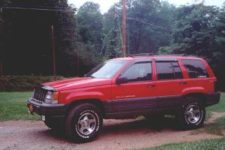 ZJ – The Grand Cherokee (1993-1998), which replaced the Grand Wagoneer (SJ) as Jeep’s luxury cruiser after a 1-year hiatus. Though much more aerodynamic than the SJ, it’s obviously less rounded than its replacement, the WJ.
ZJ – The Grand Cherokee (1993-1998), which replaced the Grand Wagoneer (SJ) as Jeep’s luxury cruiser after a 1-year hiatus. Though much more aerodynamic than the SJ, it’s obviously less rounded than its replacement, the WJ.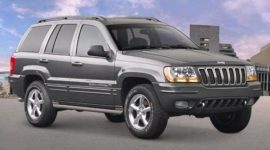 WJ – As the more bubble-shaped, aerodynamic replacement for the ZJ, it continues the Grand Cherokee name (1999-2004).
WJ – As the more bubble-shaped, aerodynamic replacement for the ZJ, it continues the Grand Cherokee name (1999-2004).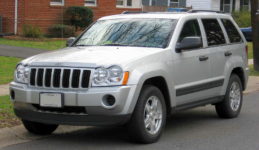 WK – The third style of Grand Cherokee has a more angular design than the WJ and also joins the Liberty in having an independent front suspension (2005-2010).
WK – The third style of Grand Cherokee has a more angular design than the WJ and also joins the Liberty in having an independent front suspension (2005-2010).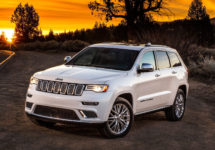 WK2 – The fourth Grand Cherokee, once again the premier Jeep model, was made from 2011-present (2017 so far).
WK2 – The fourth Grand Cherokee, once again the premier Jeep model, was made from 2011-present (2017 so far).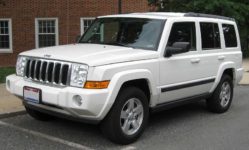 XK – The Commander was introduced as the big brother of the WK, offering 7-passenger seating and the 5.7L Hemi V8 (2006-2010).
XK – The Commander was introduced as the big brother of the WK, offering 7-passenger seating and the 5.7L Hemi V8 (2006-2010).- MK74 – The Patriot is a compact, 4-door, crossover SUV introduced in 2007. It’s bigger than the Compass, falling somewhere between the Grand Cherokee and Commander.
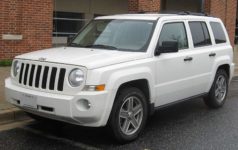
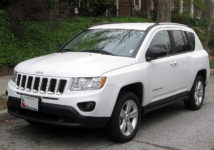 MK49 – The Compass is a compact, 4-door, crossover SUV introduced in 2007. It’s smaller than the Patriot, but slightly larger than the Liberty.
MK49 – The Compass is a compact, 4-door, crossover SUV introduced in 2007. It’s smaller than the Patriot, but slightly larger than the Liberty.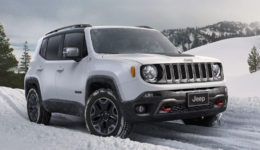 BU – The Renegade is a subcompact crossover SUV built from 2015-present (2017).
BU – The Renegade is a subcompact crossover SUV built from 2015-present (2017).
As of November 2000 (and still in March 2017), Jeep’s official web site, www.jeep.com, has a great section on Jeep heritage, showing the various vehicle lines and how they evolved.
[Last updated 15 Mar 2017]
